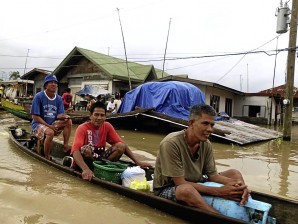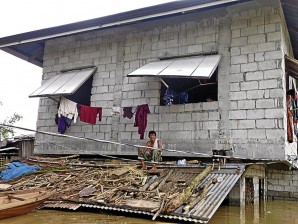Central Luzon’s focus: Rebuilding

MOVING AROUND Bancas are usually used for fishing in Pampanga’s coastal areas but these proved useful in traveling to flooded areas during Typhoon “Pedring’s” onslaught. TONETTE T. OREJAS
For officials of Central Luzon, the bigger task needing immediate attention in the region is rising after the big flood.
The Regional Development Council (RDC) started shifting to rebuilding mode as early as Oct. 5 when its leaders and members from local governments, regional agencies, state-owned firms and the private sector met with President Aquino to assess the damage brought by widespread flooding to the region.
The meeting in Bulacan was a signal to the national government to step in and help Central Luzon stand again on its feet, said City of San Fernando (Pampanga) Mayor Oscar Rodriguez. As RDC chair, the mayor presented the proposed rehabilitation priorities to Mr. Aquino and Cabinet officials.
The efforts of the RDC, as the leading policymaking body in the region, came as local governments, nongovernment and civic groups continued to come to the aid of some 2.2 million residents nine days after Typhoon “Pedring” flooded coastal villages and Typhoon “Quiel” worsened the situation on Oct. 1.
Authorities saw a region, which had fairly risen from Mount Pinatubo’s 1991 eruptions and succeeding lahar rampages, wrestling with what old-timers have considered the most destructive, life-threatening floods since 1972.
Article continues after this advertisementIn the meeting, the RDC gave a sense of why the disaster occurred based on data collated by the National Economic and Development Authority (Neda) from the Japan International Cooperation Agency (Jica) and the National Water Resources Board (NWRB).
Article continues after this advertisement“About two months of rainfall (385 millimeters) were poured in just four days (367 mm),” the council said.
All these drained to the Pampanga River Basin, which spans a watershed area of 1.034 million hectares crisscrossed by 56 tributaries in 90 towns and cities in six provinces.
The same basin receives water from the Angat Dam in Bulacan and the Pantabangan Dam in Nueva Ecija, which, in turn, get more water through transbasin tunnels in Casecnan, Nueva Vizcaya, and in the Umiray side of Aurora and Quezon provinces.
Huge floodplain
All these make Central Luzon, a huge floodplain of 5.76 million people, “susceptible to flooding, tidal rise and storm surge.”
This, the RDC said, was what happened during the back-to-back typhoons: The “extremely high tide level and storm surge” downstream pushed out the “huge flood flow” from upstream, slowing down draining to the Manila Bay.

DRIFTWOOD and wooden planks that float on floodwater are gathered, dried and used as firewood by residents stranded by widespread flooding in Pampanga. TONETTE T. OREJAS
The reconstruction plan it laid out consists of a set of responses done “from the mountains, down to the coastal areas and everything in-between.” The strategic framework is called the integrated water resource and management approach.
In particular, the RDC proposed that the Neda board’s infrastructure committee unify the dam management protocols of the National Irrigation Administration (NIA), the NWRB, weather bureau and National Power Corp.
This answers the complaint of Bulacan Gov. Wilhelmino Sy-Alvarado, who blamed the Napocor and the NIA for the release of water from the Angat, Ipo and Bustos dams that submerged 8 to 10 feet of the coastal towns of Calumpit and Hagonoy.
The RDC also recommended reviving the flood-control components of the Pampanga Delta Development Program (PDDP), speeding up the implementation of the Pinatubo Hazard Urgent Mitigation Project (PHUMP III, sourcing funds for the disaster risk reduction measures in low-lying areas of Pampanga, and funding the expansion of the flood forecasting and warning system to other river basins in Central Luzon.
Funds are also needed for the construction of adequately equipped evacuation centers in hazard-free areas.
The costs of the mostly infrastructure interventions are staggering. The PDDP Phase II alone amounts to P8.8 billion, which is worth a little more than the national government’s annual calamity fund. PHUMP III, worth P4.6 billion and running mostly on a Jica loan, has been delayed, according to a Commission on Audit report.
Rodriguez said the President has approved the continuation of the PDDP and the dredging and desilting of river channels leading to the Manila Bay.
Rebuilding task
Mr. Aquino also approved assistance to farmers so they can resume planting, he said.
Reforestation programs, while proposed by the RDC, did not mention the greening of the Nueva Ecija portions of the Sierra Madre on the eastern side of Central Luzon—one of the three sites to be funded by a P5-billion loan from Japan.
The Manila Bay Rehabilitation and Preservation Project, a spinoff of a Supreme Court decision in 2008, has several flood-reduction components that can be done in the communities, according to Lerrie Hernandez, project coordinator of the Department of the Interior and Local Government (DILG).
The bay and its watersheds straddle Central Luzon, Metro Manila and Calabarzon (Cavite, Laguna, Batangas, Rizal and Quezon). The high court ordered the DILG to direct local governments to enforce a waste management program among factories, commercial establishments and houses along riverbanks.
Fifteen other agencies were required to enforce or implement a stop to marine pollution and illegal encroachments on the bay.
Those displaced or impoverished further by the floods define the rebuilding task through their particular plight.
In a chapel that Mr. Aquino visited in Calumpit on Oct. 5, Irene Morañe, 50, wants to get back on her feet again by running a “sari-sari” store.
“I lost my cooking stove, everything’s gone. I just wash clothes to earn. I hope the government can give me livelihood,” Morañe said in Filipino.
The anticorruption campaign is also important in disaster response, according to the Center for Emergency Aid and Rehabilitation (Concern).
“Resources are scarce and so the victims themselves will have to monitor how the national and local governments are spending the money,” Concern said in a statement. “Disasters also open rooms for corruption.”